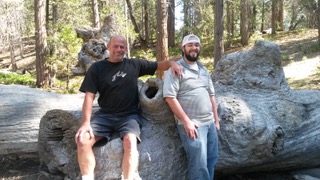When I punch in the five digit code, I steel myself to get into the elevator. To leave my sister. To hold back the tears. I remind myself that she’s finally near me at a good facility in San Francisco, and even if I stayed another hour, I’d still have to leave. It wasn’t always this way. The five-year nightmare started in 2010 when Barbara was spiraling out of control.
It’s gut-wrenching to watch a loved one suffer emotionally and physically, and be powerless to help her. I love my sister. In our 60-something years, we’ve always been close. My sister lives with schizophrenia.
As I walk through the sliding doors and go to my car, I think back to moments we had in Brockton, Massachusetts, where she lived with our mother. Every year, when I visited, we made a point to have lunch together at a local sub place, then get crème-filled donuts covered in powdered sugar, and drive to the local park that has a small lake with geese and ducks. We found a bench and basked in the sun enjoying the peaceful surroundings. We shared our problems of the day. Hers about a co-worker and mine about all the different aspects of making a social issue documentary film. We pondered solutions. In the distance the rush of a waterfall smoothed things over.
The beginning of the nightmare.
It all started when Barbara’s psychiatrist retired and she couldn’t find another she liked. Her prescriptions ran out. She wasn’t getting along with Mum and called the police. When the officers saw Barbara’s disheveled state, they took her to the emergency room for a psych evaluation. But the relative, who was her healthcare proxy, didn’t believe in psychiatrists. He took her out of the hospital, that night, before a doctor could see her.
Soon after, Mum decided to sell the house and move the two of them into an assisted living facility. I flew out to help with the move. Nothing could prepare me for the shock of seeing Barbara’s furtive looks, hollow cheeks, sagging skin, and clothes hanging off of her petite frame. I was heartbroken.
Barbara’s reality was as real to her as it was unreal to us. In the unfamiliar environment, her world was fraught with danger at every turn. The food in the freezer was poison. We had to coax her to eat a few spoonfuls. Her main activity was pacing up and down the hall for hours yelling, “The police are going to put me in jail.”
I asked her not to yell because it was disturbing the other residents. She insisted, “No one else is here.”
I gave Barbara a shower and could see her ribs. Mum and I tried reasoning with the relative to get her the help she desperately needed, but to no avail. The insurmountable brick wall of the HIPAA privacy law prevented us from taking action. It was excruciating to watch my dear sister waste away.
After months of Barbara’s disruptive behavior, the relative was forced to get her medication for the schizophrenia. It helped a little bit. Then she fell and had a minor fracture to her left hip. She was moved to a rehab. Mum and I called her everyday to persuade her to eat.
Mum had congestive heart failure. She passed away in 2013, shortly after her 86th birthday. At which point, I finally had permission to move Barbara to a facility close to me and to become her healthcare proxy.
I learn about other families who have loved ones with serious mental illness.
As I researched places to move Barbara to in San Francisco, I called her everyday around one o’clock EST. It was ten in the morning for me. I did my best to encourage her to eat and deal with her fears. Often, her last words were, “Get me out of here.” I fought back the puddle of tears.
Looking for support, I joined National Alliance on Mental Illness (NAMI) and went to their group meetings. Parents and siblings with loved ones living with serious mental illness (SMI) — schizophrenia, bipolar disorder, and schizoaffective disorder — shared the struggles and obstacles to get treatment for a person with SMI. I learned that comprehensive care is a rarity. And if a loved one is over the age of 18, families are blocked from speaking with medical professionals because of the HIPAA privacy law. Their anguish was palatable.
Hospital policies designate the limited number of acute psych beds for persons who are a danger to themselves or others. If the person is gravely disabled, they become part of the revolving door system. They get help for a few days, are put back on the street, become sicker, or go to jail for a minor offense. What if that were my sister? I felt outrage at the inhumanity.
In fact, a friend suggested that I put my sister on the street, so she would qualify for help. The thought was crushing. I argued with her that I would never do that. She was insistent that this is the only way.
I took NAMI’s Family to Family class. It was very informative. I found out about anosognosia, a mental disorder where the person is not aware they have mental illness. This certainly was the case for Barbara.
I am inspired to make a documentary.
As a teen, I took painting lessons.I went to the School of the Museum of Fine Arts in Boston. When I moved to San Francisco, I went to San Francisco State University, finished my degree, was accepted into the graduate program, and experimented with sculpture and site specific sculpture. I also took a class in poetry writing and started to write a play. At a workshop on playwriting, I heard the phrase, “personal as political.” This was it for me. I knew I wanted to use my art to make a difference.
The last Family to Family class focused on advocacy. At the end of the talk, our guest presenter asked if people wanted to get involved as an advocate. I raised my hand. “I want to make a documentary that tells our stories.” Everyone sitting around the conference table clapped.
Now, I’m working on my third documentary. PIECE OF MIND is about the internal and external barriers to care for persons living with serious mental illness. Stories are told through the compelling, intimate narratives of a mother whose son has schizophrenia and sprays chemicals on his body to kill germs; Japanese American siblings, with a sister shot by police when she refused to go to the hospital for evaluation of schizoaffective disorder, who take her case to the US Supreme Court; and a man, with bipolar disorder, whose failed suicide attempt leads to events that transform his life.
Couched in these deeply personal stories, are solutions to the dire consequences of this public health crisis. The quest for healing and normalcy sheds light on the larger issues of the lack of inpatient psychiatric beds, and the role of law enforcement in approaching persons in the midst of a psychotic break. PIECE OF MIND will inspire greater awareness and compassion, and serve as an advocacy tool for comprehensive mental health care for persons living with serious mental illness.
In April 2014, I got a call. Barbara fell, again. This time, she needed a partial hip replacement. I felt bad for her injury, but I instantly knew this meant that she had a physical disability and would qualify for MediCal to live in a skilled nursing facility. It took another year on a waiting list. Then, I moved my sister to a good facility near me.
Now, when I drive home from seeing Barbara, I feel good knowing I can help her with things. She always thanks me. She’s eating well. She’s on medication. And I try and roll with it when the delusions take over. Barbara’s never been homeless, or involved with the police. My sister is one of the lucky ones.
Visit www.pieceofmindfilm.com to watch the trailer and get more info.
Sheila Ganz, Director / Producer credits: Emmy-nominated documentary ON LIFE’S TERMS: MOTHERS IN RECOVERY, which follows five women in a residential treatment program, who are determined to learn recovery and parenting skills to regain custody of their young children. www.onlifesterms.com UNLOCKING THE HEART OF ADOPTION about the lifelong process of adoption for adoptees, first/birthparents and adoptive parents in same race and transracial adoptions. www.unlockingtheheart.com Contact: sheila.ganz@gmail.com.








